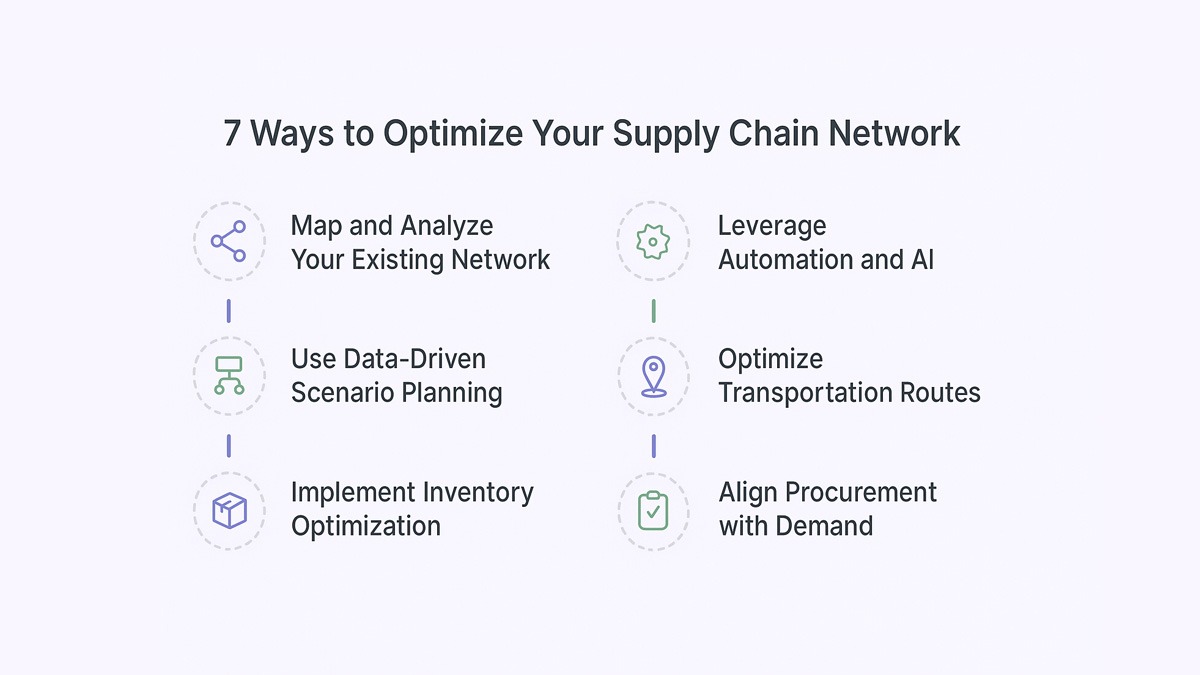

Supply Chain Network Optimization: Smarter Strategies for a Resilient Supply Chain

Supply Chain Network Optimization: Smarter Strategies for a Resilient Supply Chain
Explore strategies to optimize your supply chain network for efficiency, resilience, and faster delivery at lower costs.


Picture a network of warehouses, factories, and suppliers all working like a finely tuned orchestra. Every shipment arrives on time, every cost is justified, and every decision feels effortless. That’s what a well-optimized supply chain network looks like - smooth, predictable, and profitable. But getting there isn’t easy. With rising costs, unpredictable disruptions, and growing customer expectations, network optimization has never been more essential for business resilience and growth.
What this blog covers:
- What is supply chain network optimization?
- Why is supply chain network optimization important
- Benefits of supply chain network optimization
- Types of supply chain network optimization
- 7 ways to optimize your supply chain network
- How Spendflo helps with supply chain network optimization
- Frequently asked questions on supply chain network optimization
What is Supply Chain Network Optimization?
Supply chain network optimization is the strategic process of designing and improving the flow of goods, information, and finances across your entire supply chain. It helps businesses determine the most efficient network configuration - covering suppliers, warehouses, and transportation routes - to reduce costs, improve service levels, and enhance agility.
Why is Supply Chain Network Optimization Important
Optimizing your supply chain network isn’t just about saving money - it’s about building a business that can weather change, adapt quickly, and still deliver. Here are a few reasons it matters more than ever.

Reduces Operational Costs
When companies streamline how goods move between suppliers, warehouses, and customers, they eliminate wasteful routes, reduce fuel expenses, and minimize storage costs. It’s efficiency that directly impacts the bottom line.
Improves Delivery Speed and Efficiency
A well-optimized network shortens delivery times by positioning products closer to demand centers. That means faster fulfillment, happier customers, and fewer last-minute logistics scrambles.
Enhances Customer Satisfaction
Customer loyalty often depends on reliability. When deliveries are accurate and on time, it builds trust - and trust is hard to replace.
Supports Strategic Decision-Making
Optimization provides valuable insights into cost structures and bottlenecks. This data helps leaders make informed decisions about expansions, outsourcing, or even sustainability initiatives.
Benefits of Supply Chain Network Optimization
Before investing in technology or restructuring operations, it’s worth understanding what a well-optimized network truly delivers. Here are the core benefits businesses experience when they get it right.
Lower Inventory Costs
Excess stock ties up cash and creates waste. Optimization ensures inventory levels match actual demand, freeing up working capital and reducing holding costs.
Better Demand Planning
Data-driven forecasting aligns production and distribution with real-world needs. This minimizes shortages, overproduction, and customer frustration.
Stronger Supplier Relationships
When processes run smoothly and expectations are clear, supplier relationships thrive. Collaboration becomes proactive instead of reactive, helping both sides reduce costs and risks.
Agility in Response to Disruptions
Whether it’s a sudden supplier shutdown or a global logistics crisis, an optimized network gives companies the flexibility to reroute shipments and rebalance production without chaos.
Types of Supply Chain Network Optimization
Not all supply chain optimization is created equal. Depending on the level of decision-making - strategic, tactical, or operational - different approaches and tools come into play. Understanding these types helps businesses focus their efforts where it matters most.
Strategic Network Design
This is the big-picture view. It involves decisions like where to place warehouses, which suppliers to work with, and how many distribution centers are needed. These are long-term decisions that define the foundation of your supply chain.
Tactical Planning Optimization
At this level, businesses fine-tune their existing network. Think of adjusting transportation modes, optimizing shipping frequencies, or realigning inventory across locations. It’s about maximizing efficiency within a given framework.
Operational Optimization
Here, the focus is on day-to-day execution. From routing delivery trucks to processing orders efficiently, operational optimization deals with immediate tasks that, when improved, have a compounding effect over time.
7 Ways to Optimize Your Supply Chain Network
A successful supply chain isn’t built in a day - but it is built intentionally. These seven techniques offer actionable ways to improve efficiency, cut costs, and increase agility across your entire network.

1. Map and Analyze Your Existing Network
Start by visualizing your current supply chain. Where are the bottlenecks? Which routes or vendors underperform? Use this baseline to uncover inefficiencies and model future improvements with greater clarity.
How to Make It Happen:
- Identify high-cost or underperforming nodes (e.g. warehouses, vendors)
- Use flowcharts or digital mapping tools to visualize product movement
- Track historical data for recurring bottlenecks
- Benchmark performance across geographies
2. Use Data-Driven Scenario Planning
Leverage analytics tools to simulate various “what-if” scenarios - like supplier shutdowns, demand spikes, or fuel price changes. This helps you test resilience and prepare contingency plans without disrupting real operations.
How to Make It Happen:
- Simulate disruptions like port closures or raw material shortages
- Test cost impact of adding or removing distribution centers
- Assess carbon footprint in different scenarios
- Use software tools like Llamasoft or AnyLogic for modeling
3. Implement Inventory Optimization
Striking the right inventory balance is critical. Use demand forecasting, safety stock thresholds, and reorder point calculations to maintain stock levels that minimize costs while still meeting service targets.
How to Make It Happen:
- Set dynamic reorder points based on demand forecasts
- Classify inventory using ABC analysis
- Factor in lead time variability
- Reduce buffer stock without increasing risk
4. Leverage Automation and AI
AI-powered tools can forecast demand, manage procurement, and even reroute shipments in real time. Automation not only reduces human error but also speeds up decision-making and response times.
How to Make It Happen:
- Automate repetitive tasks like order routing and invoicing
- Use AI for predictive demand planning
- Implement chatbots for vendor communication
- Identify anomalies in spend or usage patterns
5. Optimize Transportation Routes
Even small improvements in route planning can lead to significant savings. Use route optimization software to reduce delivery times, fuel costs, and carbon emissions while improving on-time performance.
How to Make It Happen:
- Consolidate shipments to reduce partial loads
- Use GPS data to plan efficient delivery routes
- Consider intermodal transport options
- Monitor fuel efficiency and driver performance
6. Align Procurement With Demand
Procurement teams should operate in sync with sales and inventory planning. When purchasing is closely aligned with actual demand, you avoid over-ordering, reduce wastage, and respond faster to shifts in market needs.
How to Make It Happen:
- Share demand forecasts with suppliers
- Time purchases to take advantage of volume discounts
- Avoid overbuying due to poor communication
- Use procurement KPIs tied to supply chain efficiency
7. Continuously Monitor and Adjust
Optimization isn’t a one-time event. Establish KPIs, track performance regularly, and review your strategy at least quarterly. What works today may be outdated tomorrow - agility is everything.
How to Make It Happen:
- Track KPIs like cost per order, OTIF (on-time, in-full), and inventory turnover
- Hold quarterly review meetings with stakeholders
- Use dashboards for real-time visibility
- Be ready to re-route or reallocate resources as needed
How Spendflo Helps With Supply Chain Network Optimization
Spendflo brings clarity and control to one of the most overlooked pieces of supply chain optimization - SaaS procurement and spend visibility. By centralizing contract data, streamlining vendor negotiations, and aligning software tools with operational needs, Spendflo helps finance and procurement teams reduce wasted software spend, ensure compliance, and make faster, data-backed decisions. The result? A leaner, smarter supply chain ecosystem that’s both agile and cost-efficient.
Frequently Asked Questions on Supply Chain Network Optimization
What are the key benefits of supply chain network optimization?
Supply chain network optimization improves cost efficiency, delivery speed, and inventory accuracy. It also enhances customer satisfaction by ensuring timely fulfillment, while reducing transportation and warehousing costs through smarter network design.
How often should you optimize your supply chain network?
At a minimum, companies should reevaluate their supply chain network every 1–2 years. However, rapid changes in demand, supply disruptions, or major business shifts - like entering new markets - may warrant more frequent reviews.
What are the common challenges in optimizing supply chain networks?
Key challenges include limited data visibility, siloed systems, unpredictable demand, rising logistics costs, and vendor coordination. Overcoming these requires integrated tools, real-time analytics, and cross-functional collaboration.
Can small and mid-sized businesses benefit from supply chain network optimization?
Absolutely. Even smaller businesses can unlock significant savings by optimizing routes, consolidating vendors, and using digital tools to analyze and plan their supply chain footprint more effectively.
How does scenario modeling improve supply chain optimization?
Scenario modeling helps businesses simulate disruptions like demand surges or supplier delays. It supports better planning, stress-tests the network, and allows companies to respond proactively to market shifts and industry trends.
What role do modern technologies and IoT play in supply chain networks?
Technologies like AI and IoT improve real-time tracking, automate routine tasks, and enhance decision-making. They bring visibility, and precision to inventory, transport, and warehouse operations.
How can supply chains adapt to demand variability and climate change?
Using baseline models and sensitivity analysis, companies can pinpoint vulnerabilities and plan ahead. Strategies like direct plant shipments, adaptable vehicle models, and flexible routing boost resilience.










.png)




.png)










.avif)





